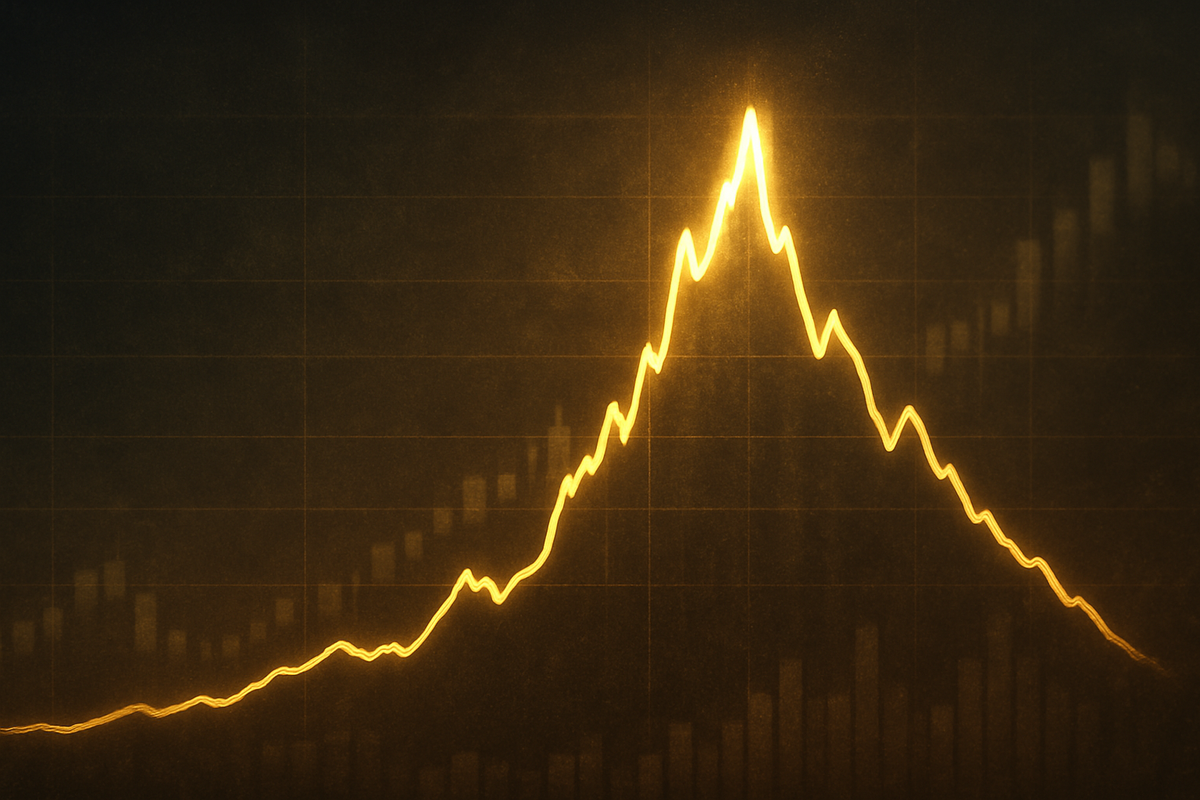
The precious metal market has been a spectacle of dramatic shifts in 2025, with gold prices soaring to unprecedented all-time highs before executing a dizzying retreat in October. This volatile journey culminated in a significant contraction of the gold market's capitalization, shedding an estimated $2.43 trillion in a mere 48 hours. Despite these jarring fluctuations and the substantial market cap erosion, a curious consensus persists among Wall Street analysts: a steadfastly bullish long-term outlook for gold, driven by a complex interplay of geopolitical tensions, economic uncertainties, and evolving monetary policies.
This article delves into the recent gold price movements, dissecting the factors behind its meteoric rise and subsequent correction, and exploring why financial experts continue to champion gold as a vital asset in the current global economic landscape. The narrative unfolds against a backdrop of shifting investor sentiment and strategic maneuvers, painting a picture of a market grappling with both immediate profit-taking pressures and enduring fundamental strengths.
Gold's Ascent and Abrupt Correction: A Detailed Account
The year 2025 has been nothing short of historic for gold. The metal embarked on a robust upward trajectory, breaching significant psychological barriers with remarkable consistency. In March 2025, gold confidently crossed the $3,000 per ounce threshold, signaling a potent bull run. This momentum accelerated, culminating in gold surpassing $4,000 per ounce on October 8, 2025. The zenith of this rally was reached on October 21, 2025, when spot gold touched an all-time high, ranging between approximately $4,381 and $4,400 per ounce. This represented an extraordinary year-to-date gain of about 54-60%, marking gold's strongest annual performance since 1979.
However, the euphoria was short-lived. Following this record-setting peak, gold prices experienced an abrupt and significant correction. On the very same day, October 21, 2025, gold recorded one of its steepest single-day drops in over a decade, plummeting by 6% to 6.3% from its peak. This translated to a loss of nearly $300 per ounce, bringing the price down to approximately $4,000 to $4,090 per ounce. As of October 23, 2025, spot gold was trading around $4,134.80 per troy ounce, reflecting a slight rebound but still about 6% below its recent all-time high. This sharp decline was primarily attributed to widespread profit-taking by investors after a prolonged rally, a strengthening U.S. dollar, and a temporary alleviation of geopolitical tensions, particularly optimism surrounding potential US-China trade deals. The broader market also witnessed a substantial contraction, with the gold market's capitalization shedding an estimated $2.43 trillion within a 48-hour window in October 2025, falling from roughly $30 trillion to $27.57 trillion.
Market Players: Winners, Losers, and Strategic Adjustments
The intense volatility in gold prices has created a dynamic environment for various market participants. Gold mining companies, such as Newmont Corporation (NYSE: NEM) and Barrick Gold Corporation (TSX: ABX), are directly impacted. During the sustained rally to all-time highs, these companies likely saw significant increases in their revenue and profitability, as the cost of extraction remained relatively stable while the selling price of their output surged. However, the recent sharp drop, though viewed as temporary by analysts, would put immediate pressure on their stock prices and could lead to short-term revenue adjustments. Producers with higher hedging ratios might be less affected by immediate spot price drops, while those unhedged would feel the full brunt.
Conversely, investors holding physically-backed gold Exchange-Traded Funds (ETFs) like SPDR Gold Shares (NYSE Arca: GLD) or iShares Gold Trust (NYSE Arca: IAU) would have seen their portfolio values swell during the ascent and contract during the recent correction, mirroring the underlying asset's performance. For jewelry retailers and industrial users of gold, the higher price environment could translate to increased input costs, potentially impacting their margins or leading to higher consumer prices. However, a slight price correction might offer some relief. Central banks, a significant "player" in the gold market, continue their aggressive accumulation, acting as a consistent buyer and providing a floor for prices, thus benefiting from diversification and hedging against global risks, regardless of short-term fluctuations.
Wider Significance: Gold's Enduring Role in a Shifting Global Economy
Gold's recent performance is not an isolated event but rather a reflection of deeper underlying trends in the global financial landscape. Its rally to all-time highs underscored its enduring role as a premier safe-haven asset amidst persistent geopolitical risks—including ongoing conflicts (e.g., Israel-Hamas), US-China trade tensions, and concerns over the U.S. government shutdown. These uncertainties, coupled with lingering inflation concerns and worries about escalating government debt burdens, have consistently fueled investor demand for gold.
The aggressive accumulation of gold by central banks worldwide is another critical factor. These institutions have been buying gold at an unprecedented rate, consistently acquiring over 1,000 tonnes annually since 2022. This strategic buying, driven by a desire to diversify away from the U.S. dollar and hedge against geopolitical and economic risks, provides a robust and durable floor for gold prices. Furthermore, expectations of future interest rate cuts by the Federal Reserve (with predictions of two more cuts by the end of 2025 and a total of 100 basis points through mid-2026) make non-yielding assets like gold relatively more attractive compared to interest-bearing alternatives. This trend aligns with a broader de-dollarization movement among nations and investors, further solidifying gold's role as a store of value and an alternative reserve asset. Historically, gold has performed strongly during periods of economic uncertainty and monetary easing, and its current trajectory draws parallels to past bull markets driven by similar macroeconomic forces.
What Comes Next: Navigating the Golden Horizon
Looking ahead, the gold market is poised for continued dynamism. In the short term, further price corrections or consolidation cannot be ruled out as investors continue to take profits or react to temporary shifts in market sentiment. However, the prevailing sentiment among Wall Street analysts suggests that the recent drop is a healthy correction within a broader structural bull market rather than a reversal. Long-term possibilities include gold retesting its recent highs and potentially pushing even further.
Strategic pivots for investors might include "buying the dip" during corrections, diversifying portfolios with gold-backed assets, and closely monitoring geopolitical developments and central bank policies. Market opportunities may emerge for those seeking to capitalize on gold's safe-haven appeal during periods of heightened uncertainty or as a hedge against inflation. Challenges could include increased volatility and the difficulty of timing market entry and exit points. Analyst forecasts underscore this long-term optimism: Goldman Sachs predicts gold to reach $4,000 per troy ounce by mid-2026 and $4,900 by December 2026. Morgan Stanley revised its 2026 forecast to $4,400 per ounce. JPMorgan anticipates gold prices averaging around $3,675 per ounce in late 2025, rising towards $4,000 by mid-2026, and potentially exceeding $8,000 per ounce by 2028. HSBC projects $5,000 an ounce in the first half of 2026, while Bank of America models suggest gold could ultimately be propelled toward the $6,000 per ounce level.
A Golden Future: Resilience Amidst Volatility
In summary, the gold market in 2025 has been characterized by extreme volatility, witnessing both historic all-time highs and sharp, albeit short-lived, corrections, including a significant $2.43 trillion market cap decline. Despite these dramatic swings, the overarching sentiment from Wall Street remains robustly bullish, anchored by strong fundamental drivers. Key takeaways include gold's reinforced status as a safe-haven asset, unprecedented central bank accumulation, and expectations of future monetary easing by central banks.
Moving forward, the market is expected to continue its upward trajectory, albeit with periodic corrections. Gold's significance as a monetary asset and a hedge against global instability is only strengthening. Investors should closely watch for ongoing geopolitical developments, further actions by central banks regarding interest rates and gold reserves, and inflation data. While short-term fluctuations are inevitable, the long-term outlook for gold appears bright, positioning it as a critical component of diversified portfolios in an increasingly uncertain world.
This content is intended for informational purposes only and is not financial advice






